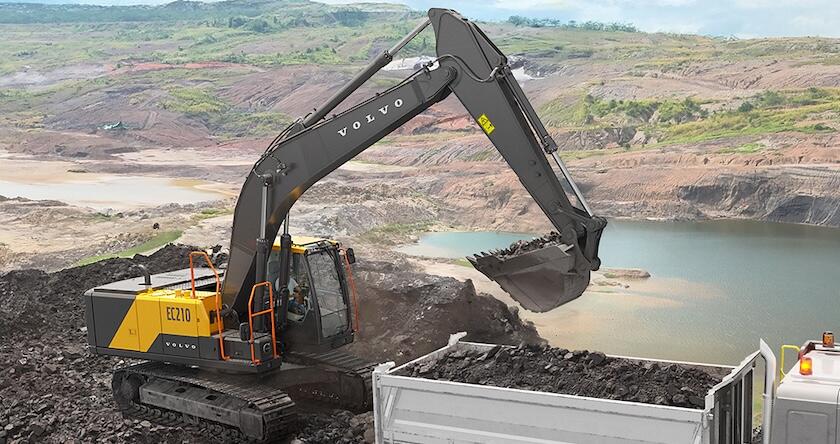Understanding Excavator Hydraulics: Part 2

In Part 1 of this excavator hydraulics series, I covered the fundamentals of excavator hydraulics, including the difference between hydraulic pressure and flow, and how Volvo’s electric-over-hydraulic (EH) system enhances performance.
In this second part, I'll discuss the differences between pilot controls and EH controls, and how those differences impact excavator operation.
Key Takeaways
- Electric-over-hydraulic (EH) controls offer a more responsive and precise machine operation compared to traditional pilot controls due to their use of electrical signals instead of low-pressure hydraulic fluid.
- While the increased responsiveness of EH controls can initially feel "jerky," you can adapt by starting slowly, adjusting personal settings like work modes and focusing on smooth movements.
- The benefits of EH controls include improved efficiency, productivity and easier integration of advanced technologies like Volvo Active Control, making them a significant advancement in excavator technology.
Excavator Controls: Pilot vs. Electric-Over-Hydraulic (EH)
If you've spent any time in excavators over the years, you're likely familiar with pilot controls. With pilot controls, the system uses low-pressure hydraulic fluid to activate the main hydraulic valves, which in turn control the high-pressure, high-flow fluid that powers the machine's movements. It's a system that's been around for a while and has proven to be pretty reliable.
That said, newer excavators, like the latest Volvo excavator models, now use EH controls. Instead of relying on pilot pressure, excavator EH systems use electrical current to control the main hydraulic valves. The electrical current adjusts to control high pressure and high flow.
What EH Controls Mean for Excavator Operation
This switch to EH controls might seem like a small change, but it can make a big difference in how the machine responds. I’ve heard some operators say that the newer EH-controlled machines feel "jerky" compared to older models. This is a common experience, and it's important to understand why it happens.
EH controls make the machine much more responsive. When you move the lever, the machine reacts more quickly and precisely than with pilot controls. For operators used to the slightly slower response of pilot controls, this increased responsiveness can be surprising and sometimes frustrating. It's like going from driving a standard sedan to getting behind the wheel of a sports car — the difference in sensitivity can take some getting used to. But if you spend some time fine-tuning your movements in the cab, you’ll quickly appreciate the added responsiveness of your excavator.

Tips for Adjusting to EH Excavator Controls
If you're transitioning to an excavator with EH controls, here are a few tips to help you adapt:
- Start Slow: Don't go straight into "heavy" mode or max your RPMs right away. Older pilot systems required higher RPMs to increase flow and speed, but with EH, that's not the case. Start with lower RPMs to get a feel for the machine's responsiveness, then move up as you adjust.
- Adjust Your Personal Settings: With Volvo excavators, you have the option to select Soft, Normal or Active and adjust your excavator’s responsiveness. Consider starting in Soft mode first, then move up as you get more comfortable with the machine’s responses.
- Smooth Movements: Focus on making smooth, deliberate movements with the controls. Avoid quick motions because your excavator will respond very accurately to them, which can result in that "jerky" feeling I mentioned earlier.
- Practice: Take some time to practice in a safe, open area to get comfortable with the excavator's response. The more you practice, the better you'll become at smoothly controlling your machine.
The Benefits of EH Excavator Controls
While there's a learning curve, EH controls offer significant advantages. First, the increased responsiveness leads to greater efficiency and productivity once you're comfortable with it.
Another major benefit of EH excavator controls is the ability to easily integrate advanced technologies. Features like Volvo Dig Assist in-cab machine control and Volvo Active Control can be added more seamlessly to EH-controlled machines because add-on electrical control systems don't have to be incorporated into the machine — they’re already there. Retrofitting these control systems plus the new technologies onto pilot-controlled machines is more complex and costly.
I should also mention that the 10 Volvo excavator work modes on our new series of machines allows you to tailor hydraulic response to the task at hand, from heavy lifting to fine grading.
In essence, EH controls are a step forward in excavator technology. They offer improved performance, greater efficiency and easier integration of new features. Yes, they require some adjustment for those of you used to older systems — but in the long run, the benefits make the transition worthwhile.
If you haven’t yet used EH controls on an excavator, I recommend reaching out to your local Volvo dealer and they can show you how it works.
Danny Freeman
Sales Training and Product Support Manager
Before working for Volvo, Danny began his career within his family construction business. Currently, he’s a sales training and product support manager with several decades of construction and demolition experience.

